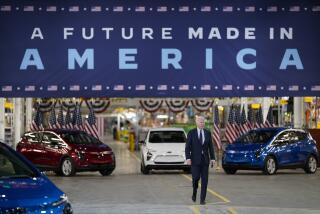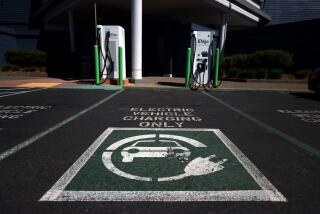The 500-Mile-Per-Gallon Solution
Soaring oil prices -- crude is over $55 a barrel and unleaded gasoline over $2 a gallon -- are not much of an economic or political issue. Yet.
In absolute terms, todayâs prices are still half of the 1970s peaks, and the U.S. economy has become much less dependent on petroleum since then. (Computers run on electricity, not gasoline.) But imagine what would happen if Al Qaeda were to hit the giant Ras Tanura terminal in Saudi Arabia, where a tenth of global oil supplies are processed every day. Prices could soar past $100 a barrel, and the U.S. economy could go into a tailspin. As it is, high oil prices provide money for Saudi Arabia to subsidize hate-spewing madrasas and for Iran to develop nuclear weapons.
Both Democrats and Republicans know this, but neither party is serious about solving this growing crisis. Democrats who couldnât tell the difference between a caribou and a cow grandstand about the sanctity of the Arctic National Wildlife Refuge, even though 70% of Alaskans are happy to see a bit of drilling in this remote tundra. Republicans, for their part, pretend that tapping ANWR will somehow solve all of our problems. If only. A government study finds that, with ANWR on line, the U.S. will be able to reduce its dependence on imported oil from 68% to 65% in 2025.
How to do better? Biking to work or taking the train isnât the answer. Even if Americans drive less, global oil demand will surge because of breakneck growth in India and China. The Middle East, home of two-thirds of the worldâs proven oil reserves, will remain of vital strategic importance unless we can develop alternative sources of automotive propulsion and substantially decrease global, not just American, demand for petroleum. An ambitious agenda to achieve those goals has been produced by Set America Free, a group set up by R. James Woolsey, Frank Gaffney and other national security hawks.
They advocate using existing technologies -- not pie-in-the-sky ideas like hydrogen fuel cells -- to wean the auto industry from its reliance on petroleum. Hybrid electric cars such as the Toyota Prius, which run on both electric motors and gas engines, already get more than 50 miles per gallon. Coming soon are hybrids that can be plugged into a 120-volt outlet to recharge like a cellphone. Theyâll get even better mileage.
Add in âflexible fuelâ options that already allow many cars to run on a combination of petroleum and fuels like ethanol (derived from corn) and methanol (from natural gas or coal), and you could build vehicles that could get -- drum roll, please -- 500 miles per gallon of gasoline. Thatâs not science fiction; thatâs achievable right now.
Set America Free estimates that if we convert entirely to flexible-fuel, plug-in hybrid electric vehicles, U.S. gasoline imports in 20 years will drop by two-thirds. As important, because Americans are the worldâs biggest car buyers, U.S. preferences would reshape the global automotive industry. Carmakers would wind up shipping hybrid electrics to Europe and Asia too. President Bush could hasten the transition through an international agreement to move major economies away from oil dependency. This would not only reduce the Middle Eastâs strategic importance but also help reduce emissions to Kyoto-mandated levels.
There is, of course, a catch. Moving to hybrid electric cars wonât be cheap. Automakers would have to retool their wares, gas stations would have to add alcohol-fuel pumps, parking lots would have to add electric outlets. Set America Free puts the price tag at about $12 billion over the next four years. It sounds like a lot of money, but it could easily be financed by slightly raising U.S. gasoline taxes (currently about 43 cents a gallon), which are much lower than in Europe and Japan. Higher taxes could also be used to encourage more domestic oil exploration and production, given that petroleum will never be entirely eliminated as an energy source.
There are many untapped sources of gasoline in North America, such as the tar sands of Alberta, Canada, and the shale of Utah, Wyoming and Colorado. But extracting oil from such sources costs at least three times more than pumping it out of the Arabian desert. Congress could make this more economically feasible by imposing a higher tax on oil that doesnât come from North America.
Needless to say, this runs smack dab into Republican orthodoxy that opposes new taxes and regulations, while the prospect of more drilling raises the hackles of Democratic environmentalists. Absent some political courage in both parties, we will continue to be at OPECâs mercy.






